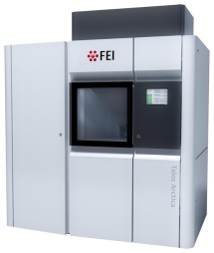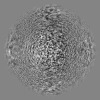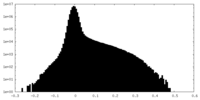+ Open data
Open data
- Basic information
Basic information
| Entry |  | ||||||||||||
|---|---|---|---|---|---|---|---|---|---|---|---|---|---|
| Title | Human PRC2 - AavLEA1 (1:12 molar ratio) | ||||||||||||
 Map data Map data | |||||||||||||
 Sample Sample |
| ||||||||||||
 Keywords Keywords | PRC2 / AavLEA1 / air-water-interface / DNA BINDING PROTEIN | ||||||||||||
| Biological species |  Homo sapiens (human) Homo sapiens (human) | ||||||||||||
| Method | single particle reconstruction / cryo EM / Resolution: 3.62 Å | ||||||||||||
 Authors Authors | Abe KM / Li G / Grant T / Lim CJ | ||||||||||||
| Funding support |  United States, 3 items United States, 3 items
| ||||||||||||
 Citation Citation |  Journal: Nat Commun / Year: 2024 Journal: Nat Commun / Year: 2024Title: Small LEA proteins mitigate air-water interface damage to fragile cryo-EM samples during plunge freezing. Authors: Kaitlyn M Abe / Gan Li / Qixiang He / Timothy Grant / Ci Ji Lim /  Abstract: Air-water interface (AWI) interactions during cryo-electron microscopy (cryo-EM) sample preparation cause significant sample loss, hindering structural biology research. Organisms like nematodes and ...Air-water interface (AWI) interactions during cryo-electron microscopy (cryo-EM) sample preparation cause significant sample loss, hindering structural biology research. Organisms like nematodes and tardigrades produce Late Embryogenesis Abundant (LEA) proteins to withstand desiccation stress. Here we show that these LEA proteins, when used as additives during plunge freezing, effectively mitigate AWI damage to fragile multi-subunit molecular samples. The resulting high-resolution cryo-EM maps are comparable to or better than those obtained using existing AWI damage mitigation methods. Cryogenic electron tomography reveals that particles are localized at specific interfaces, suggesting LEA proteins form a barrier at the AWI. This interaction may explain the observed sample-dependent preferred orientation of particles. LEA proteins offer a simple, cost-effective, and adaptable approach for cryo-EM structural biologists to overcome AWI-related sample damage, potentially revitalizing challenging projects and advancing the field of structural biology. | ||||||||||||
| History |
|
- Structure visualization
Structure visualization
| Supplemental images |
|---|
- Downloads & links
Downloads & links
-EMDB archive
| Map data |  emd_43623.map.gz emd_43623.map.gz | 117.9 MB |  EMDB map data format EMDB map data format | |
|---|---|---|---|---|
| Header (meta data) |  emd-43623-v30.xml emd-43623-v30.xml emd-43623.xml emd-43623.xml | 13.9 KB 13.9 KB | Display Display |  EMDB header EMDB header |
| FSC (resolution estimation) |  emd_43623_fsc.xml emd_43623_fsc.xml | 10.6 KB | Display |  FSC data file FSC data file |
| Images |  emd_43623.png emd_43623.png | 63.1 KB | ||
| Filedesc metadata |  emd-43623.cif.gz emd-43623.cif.gz | 4.1 KB | ||
| Others |  emd_43623_half_map_1.map.gz emd_43623_half_map_1.map.gz emd_43623_half_map_2.map.gz emd_43623_half_map_2.map.gz | 115.9 MB 115.9 MB | ||
| Archive directory |  http://ftp.pdbj.org/pub/emdb/structures/EMD-43623 http://ftp.pdbj.org/pub/emdb/structures/EMD-43623 ftp://ftp.pdbj.org/pub/emdb/structures/EMD-43623 ftp://ftp.pdbj.org/pub/emdb/structures/EMD-43623 | HTTPS FTP |
-Validation report
| Summary document |  emd_43623_validation.pdf.gz emd_43623_validation.pdf.gz | 823.5 KB | Display |  EMDB validaton report EMDB validaton report |
|---|---|---|---|---|
| Full document |  emd_43623_full_validation.pdf.gz emd_43623_full_validation.pdf.gz | 823.1 KB | Display | |
| Data in XML |  emd_43623_validation.xml.gz emd_43623_validation.xml.gz | 18.8 KB | Display | |
| Data in CIF |  emd_43623_validation.cif.gz emd_43623_validation.cif.gz | 24.3 KB | Display | |
| Arichive directory |  https://ftp.pdbj.org/pub/emdb/validation_reports/EMD-43623 https://ftp.pdbj.org/pub/emdb/validation_reports/EMD-43623 ftp://ftp.pdbj.org/pub/emdb/validation_reports/EMD-43623 ftp://ftp.pdbj.org/pub/emdb/validation_reports/EMD-43623 | HTTPS FTP |
-Related structure data
- Links
Links
| EMDB pages |  EMDB (EBI/PDBe) / EMDB (EBI/PDBe) /  EMDataResource EMDataResource |
|---|
- Map
Map
| File |  Download / File: emd_43623.map.gz / Format: CCP4 / Size: 125 MB / Type: IMAGE STORED AS FLOATING POINT NUMBER (4 BYTES) Download / File: emd_43623.map.gz / Format: CCP4 / Size: 125 MB / Type: IMAGE STORED AS FLOATING POINT NUMBER (4 BYTES) | ||||||||||||||||||||||||||||||||||||
|---|---|---|---|---|---|---|---|---|---|---|---|---|---|---|---|---|---|---|---|---|---|---|---|---|---|---|---|---|---|---|---|---|---|---|---|---|---|
| Projections & slices | Image control
Images are generated by Spider. | ||||||||||||||||||||||||||||||||||||
| Voxel size | X=Y=Z: 1.064 Å | ||||||||||||||||||||||||||||||||||||
| Density |
| ||||||||||||||||||||||||||||||||||||
| Symmetry | Space group: 1 | ||||||||||||||||||||||||||||||||||||
| Details | EMDB XML:
|
-Supplemental data
-Half map: #1
| File | emd_43623_half_map_1.map | ||||||||||||
|---|---|---|---|---|---|---|---|---|---|---|---|---|---|
| Projections & Slices |
| ||||||||||||
| Density Histograms |
-Half map: #2
| File | emd_43623_half_map_2.map | ||||||||||||
|---|---|---|---|---|---|---|---|---|---|---|---|---|---|
| Projections & Slices |
| ||||||||||||
| Density Histograms |
- Sample components
Sample components
-Entire : Human polycomb repressive complex 2
| Entire | Name: Human polycomb repressive complex 2 |
|---|---|
| Components |
|
-Supramolecule #1: Human polycomb repressive complex 2
| Supramolecule | Name: Human polycomb repressive complex 2 / type: complex / ID: 1 / Parent: 0 |
|---|---|
| Source (natural) | Organism:  Homo sapiens (human) Homo sapiens (human) |
-Experimental details
-Structure determination
| Method | cryo EM |
|---|---|
 Processing Processing | single particle reconstruction |
| Aggregation state | particle |
- Sample preparation
Sample preparation
| Concentration | 0.33 mg/mL | ||||||||||||
|---|---|---|---|---|---|---|---|---|---|---|---|---|---|
| Buffer | pH: 7.5 Component:
| ||||||||||||
| Grid | Model: C-flat-1.2/1.3 / Material: GOLD / Mesh: 300 | ||||||||||||
| Vitrification | Cryogen name: ETHANE / Chamber humidity: 95 % / Chamber temperature: 277 K / Instrument: FEI VITROBOT MARK IV |
- Electron microscopy
Electron microscopy
| Microscope | FEI TALOS ARCTICA |
|---|---|
| Specialist optics | Energy filter - Slit width: 20 eV |
| Image recording | Film or detector model: GATAN K3 BIOQUANTUM (6k x 4k) / Average electron dose: 50.0 e/Å2 |
| Electron beam | Acceleration voltage: 200 kV / Electron source:  FIELD EMISSION GUN FIELD EMISSION GUN |
| Electron optics | C2 aperture diameter: 70.0 µm / Illumination mode: FLOOD BEAM / Imaging mode: BRIGHT FIELD / Nominal defocus max: 2.5 µm / Nominal defocus min: 1.0 µm |
| Experimental equipment |  Model: Talos Arctica / Image courtesy: FEI Company |
 Movie
Movie Controller
Controller
















 Z (Sec.)
Z (Sec.) Y (Row.)
Y (Row.) X (Col.)
X (Col.)





































